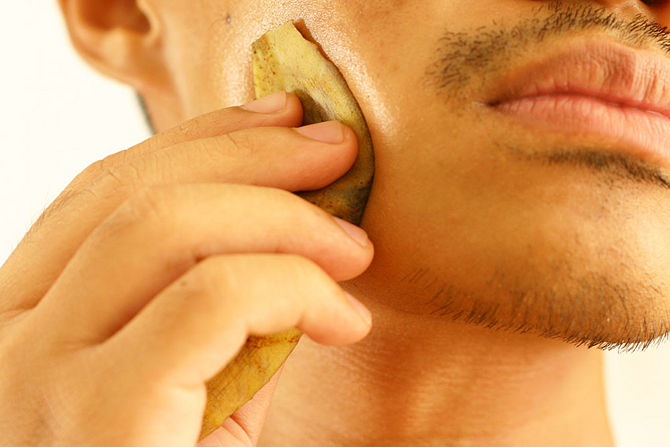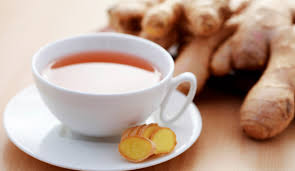With people all over the globe spending billions of dollars on skin-care products every year, you’d think cosmetics companies had replicated the fountain of youth in the laboratory. In fact, skin creams have gotten more and more expensive and less and less based on real science. According to most experts who aren’t hawking half-ounce jars of $200 youth serum, the science behind skin care is simpler than most of us think.
As with most health benefits, it comes down to lifestyle rather than how much you can afford to spend on products. The things you can do to beautify your skin are remarkably similar to what you can do to live longer and better: Get regular exercise, sleep enough, avoid sun damage and eat well. And, as it turns out, foods can work from the inside out or the outside in to brighten your complexion. So what are we looking at when it comes to beautiful skin from your own kitchen? In this article, find out what you’ll want to throw in your shopping cart to make your skin gorgeous and why those foods work on traits like smoothness and tone.
First up: a dessert ingredient for your epidermis.
1. Honey
We’ve all heard that a diet high in sugar is bad for the body, but it turns out that slathering a substance that’s 98 percent sugar on your face is just fine.
Honey is a natural humectant, which means that it both attracts moisture and helps lock it in. It’s exactly what parched skin craves, so if you’re suffering from itchy, flaky skin, add some honey to your bath.
But honey’s skin benefits aren’t limited to its moisturizing properties. Honey is also a potent antibacterial agent.
Its high sugar content combined with its acidity makes it a poor environment for bacteria to flourish. Diluted honey generates hydrogen peroxide, which no doubt a school nurse has dabbed on one of your scrapes to disinfect it. Before World War II, honey was often used in wound dressings to stave off infection. It’s growing in popularity again as studies have shown that it might be an effective weapon against strains of bacteria that are resistant to antibiotics, like MRSA. An added benefit is that it seems to make wounds smell better, no small matter when it comes to festering ulcers.
Because of its antibacterial qualities, many people think honey might also be beneficial for acne. But know that not all honeys are created equal — where it comes from and how it’s processed affect its antibacterial properties.
2. Seafood
Most of us have heard that fish can be really good for your overall health — it’s a primary component in what’s known as the Mediterranean diet. Many types of fish and shellfish can also work wonders for the skin, especially oysters and fatty fish like salmon.
The primary nutrients that make fish so good for your complexion are zinc and omega-3 fatty acids. Increasing omega-3 intake can reduce dryness and inflammation. Inflammation can cause skin to age faster, and research shows that getting too little omega-3 may contribute to inflammatory disorders like eczema and psoriasis [source: University of Maryland Medical Center]. Omega-3 fatty acids can also help keep the heart’s arteries clear and thus improve circulation. Good circulation is crucial to skin health.
Zinc can help fight acne because it’s involved in metabolizing testosterone, which affects the production of an oily substance caused sebum, a primary cause of acne. Zinc also assists in new-cell production and the sloughing off of dead skin, which gives the skin a nice glow.
You’ll also find these benefits in flaxseed oil and walnuts.
On the next page, an ingredient that you do want on your face, despite a popular idiom.
3. Egg
When it comes to eggs, there’s no need to separate the benefits — both yolks and whites hold skin care gifts.
Egg yolks are an important source of vitamin A, which helps your skin repair itself. If you’re not getting enough of it from your diet, it will show in your skin. But the vitamin also works from the outside. Vitamin A derivatives like tretinoin (more commonly known by the brand name Retin-A) have been shown to help erase acne as well as wrinkles.
Egg yolks are also a source of biotin, a B-complex vitamin, which is needed for healthy skin and nails. There isn’t much evidence to support popular claims that biotin supplements will improve your hair and nails, but it’s definitely something you want on your plate [source: University of Maryland Medical Center]. (In an interesting twist, raw egg whites can interfere with the body’s absorption of biotin, anti-yolk folks might want to reconsider their stance.) The yolk also contains lecithin, which is an emollient that softens the skin. Try an egg yolk beaten with some olive oil for an inexpensive hair mask.
The white of an egg, the albumen, is composed of 40 different proteins and water. The egg white facial is known as an “instant facelift” because of its temporary tightening effect. But it’s those proteins in the white that make it such a great conditioner; the ionic charge of its amino acids helps it bind to hair. It’s also possible that one of the proteins can help skin that’s irritated from the sun
4. Citrus Fruits
Vitamin C is a prime skin-care ingredient in tons of beauty creams. This vitamin aids in the body’s production of collagen, a protein that forms the basic structure of your skin. Collagen breakdown, which starts speeding up significantly around the age of 35, can leave your skin saggy. Consuming extra vitamin C in foods like oranges, grapefruits, Acerola cherries (a single Acerola has 100 percent of your vitamin C for the day) and tomatoes can help tighten the skin and prevent wrinkles.
Vitamin C also may fight inflammation, and its antioxidantproperties can neutralize the free radicals (highly reactive oxygen molecules) that damage cells and can prematurely age your face.
In case you get tired of eating all that fruit, hot peppers, bell peppers and sprouts also have good amounts of vitamin C.
5. Oatmeal
f you have eczema or have suffered through a nasty bout of poison ivy, you know how soothing a bath with milk, uncooked oatmeal and a little bit of honey can be.
Oatmeal is nature’s balm for dry, itchy, irritated skin — just ask the ancient Egyptians and Romans.
Colloidal oatmeal, which is made by pulverizing and boiling oats, is the ingredient you’ll most often see in skin care products. It fights itch, helps keep moisture and contributes to the barrier your skin tries to maintain to protect you from outside elements.
Oats happen to be full of all sorts of goodies
- Fats that lubricate the skin
- Polysaccharides that cling to your skin and eliminate flakes
- Saponins, natural cleansers that have antifungal and antibacterial qualities
- Polyphenols that are anti-inflammatories and antioxidants
- Proteins that help the skin barrier
- Starches and beta glucan that hold water in
Talk about a lot of bang for your buck.
6. Red and Green Vegetables
Skin is the body’s largest organ. It makes sense, then, that what’s good for your whole body is also good for your skin — and as far as food goes, it doesn’t get much better than vegetables. You’ll especially want to look for red-orange and green vegetables like carrots, sweet potatoes and spinach.
Orange-red vegetables are full of beta-carotene. Our bodies convert beta-carotene into vitamin A, which acts as an antioxidant, preventing cell damage and premature aging.
Spinach and other green, leafy foods provide tons of vitamin A, too, which helps your skin produce more fresh new cells and get rid of the old ones, reducing dryness and keeping your face looking bright and young.
Mangoes are also a great source of vitamin A. It’s best to get this vitamin from food and not from supplements , though, since too much vitamin A can cause health problems
7. Shea Butter
Any woman looking to get rid of stretch marks has at some point been recommended shea butter to lighten those tell-tale discolorations. While there’s no strong body of evidence to back up that particular claim, shea butter is packed with skin care benefits.
This substance from sub-Saharan Africa has been used for generations to treat ailments from arthritis to leprosy. It’s even used on dogs to protect their skin and paws.
Shea butter is composed mainly of triglycerides, such as palmitic, stearic, oleic and linoleic fatty acids. These make it a fantastic emollient, and, combined with its thick texture and creaminess, a moisturizer that really sticks.
But it’s the other part of shea butter that researchers are more interested in: the unsaponifiables. They’re the parts of oils and fats that don’t form soaps. Shea butter is full to the brim with them, and they have antioxidant, anti-inflammatory and antimicrobial properties. And, to make it even better, cinnamic acids in the unsaponifiables absorb UV radiation.
8. Nuts
As with many of the skin-healthy foods on our list, the good stuff in nuts — especially almonds — has to do with antioxidant activity. Vitamin E combats skin-aging free radicals, especially protecting skin from sun damage due to UV-sunlight-generated free radicals. Vitamin E also tends to help skin hold in moisture, relieving dryness and making skin look younger.
Pairing vitamin E with selenium can enhance its antioxidant abilities, so go ahead and throw some almonds into your cottage cheese (great source of selenium) for a skin-revitalizing snack.
Almonds, pistachios and walnuts also provide a nice supply of those omega-3 fatty acids that we mentioned earlier.
9. Goat Milk
Goat’s milk cheese is delicious, but it turns out that goat milk is also a treat for your skin. It contains lactic acid, a natural exfoliant, as well as vitamins A and E. An abundance of triglycerides act to hydrate the skin and keep moisture in.
But there’s a secret ingredient to give an added boost to the moisturizing quotient: caprylic acid.
This fatty acid creates a lower pH in the skin’s mantle, the barrier that protects us from bacteria and infection. Balancing alkalinity in this way makes it easier for the skin to absorb all the nutrients, so they don’t just end up sitting on top of the epidermis.
10. Whole Grains
The “whole food” movement has whole-body advantages, not the least of which is great-looking skin.
Whole foods are basically unprocessed — whole wheat bread instead of white bread, for instance. Whole grain buckwheat is a good source for the antioxidant rutin, which helps combat inflammation-related skin damage. Wheat germ provides the B-vitamin biotin, which assists cells in processing fats. If you don’t have enough biotin in your body, your skin can become dry and scaly.
In general, whole grains instead of processed carbohydrates can improve your complexion. Processed (or refined) flours can cause an insulin spike, which in turn can encourage acne. Replacing your refined-flour pancakes with buckwheat pancakes is a good acne-reducing move. Incidentally, this would also help reduce your risk of developing diabetes.













